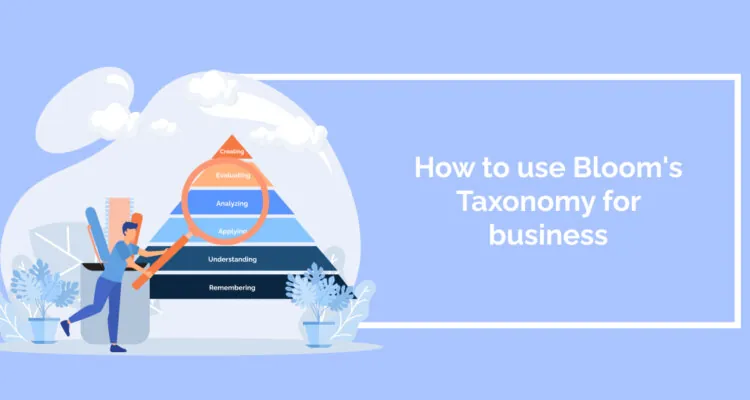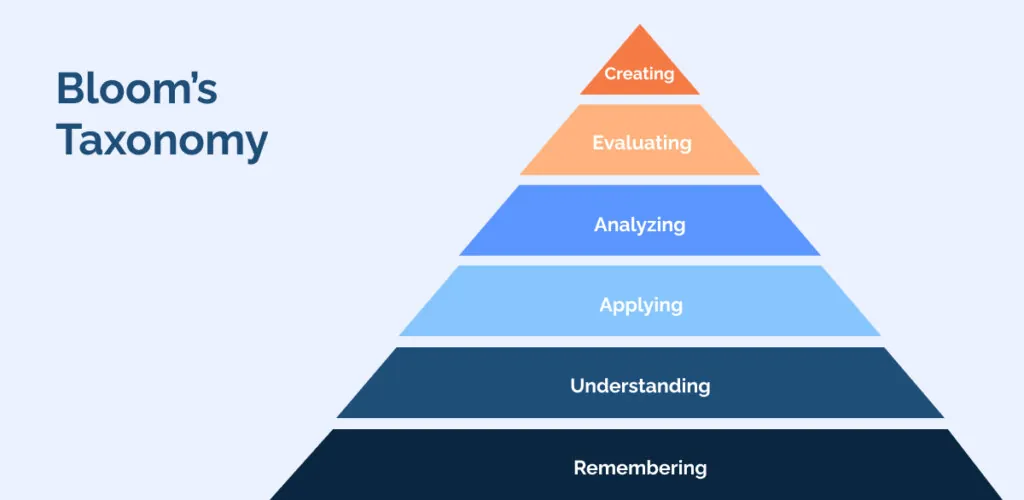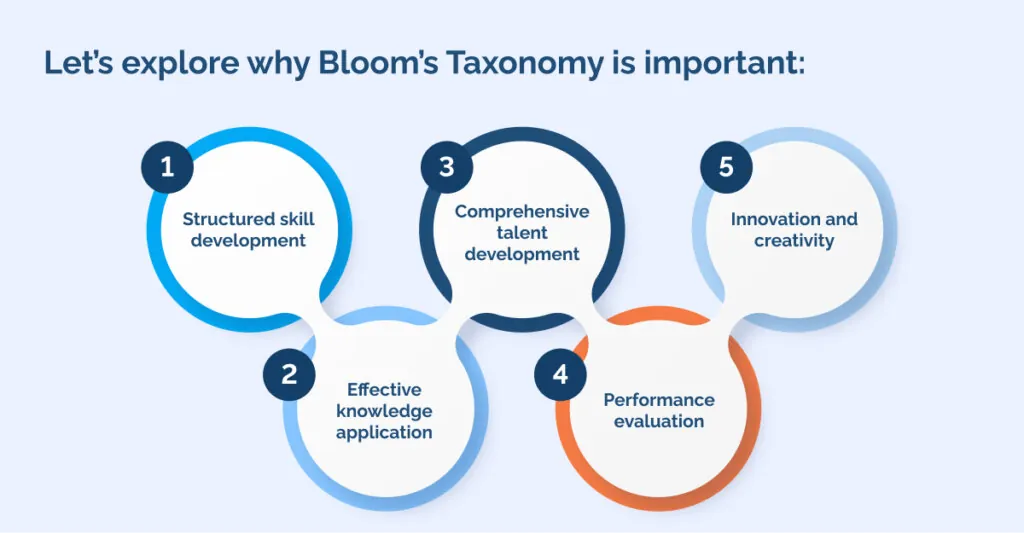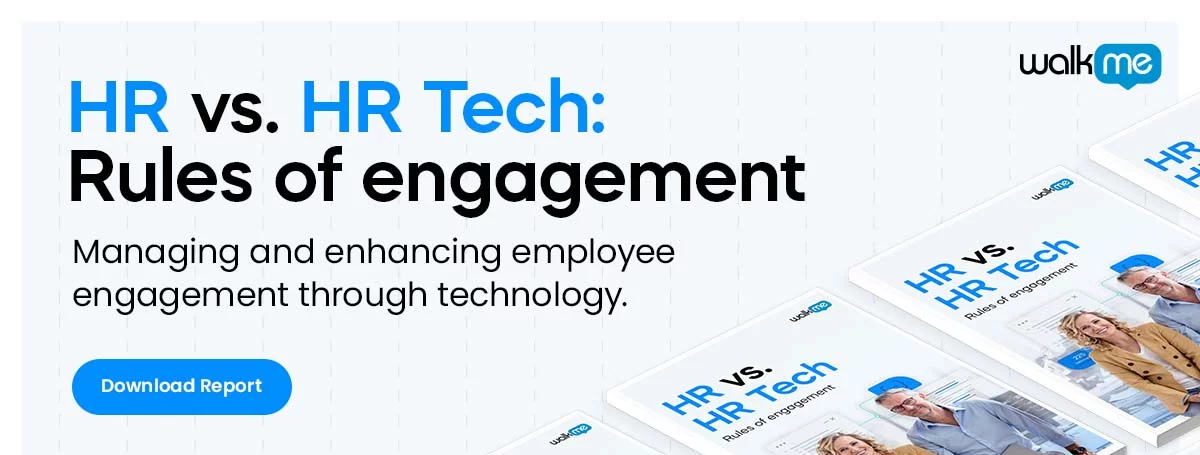
Bloom’s Taxonomy is a valuable tool for HR leaders, offering a structured approach to skill development.
From foundational tasks like recalling information to advanced abilities such as analyzing data and fostering creativity, the framework aligns with the diverse demands of HR roles. For talent development, it aids in evaluating employee performance and promoting a creative work environment.
Integrating Bloom’s Taxonomy into HR processes enables leaders to strategically enhance team skills, ensuring a comprehensive approach to effective human resource management.
This article will guide HR leaders through the dynamic impact of Bloom’s Taxonomy on skills development, offering a strategic roadmap to unlock untapped potential and elevate modern workforce capabilities.
What is Bloom’s Taxonomy?
Bloom’s Taxonomy is a hierarchical framework that categorizes cognitive skills essential for learning. Developed by Benjamin Bloom in the 1950s, it classifies educational objectives into six levels, ranging from simple recall of facts to higher-order thinking skills.
Bloom’s taxonomy comprises the following six levels:
- Remembering
- Understanding
- Applying
- Analyzing
- Evaluating
- Creating

Each level represents a progressively more complex cognitive process and can aid HR leaders in designing effective instructional strategies.
HR leaders can leverage this tool to design targeted training programs, fostering an agile workforce.
While typically applied in learning and development (L&D) initiatives by teachers of K-12 and college students, Bloom’s Taxonomy can be tailored to the workplace L&D approach for HR professionals to enhance skills.
Why is Bloom’s Taxonomy important?
Bloom’s Taxonomy provides a systematic approach to skill development, precise application of knowledge, comprehensive talent cultivation, nuanced performance evaluation, and serves as a catalyst for innovative workplace transformation.
Think of it as the GPS for HR leaders, guiding them through the intricate journey of skill development and redefining how organizations approach learning and training.

Let’s explore why Bloom’s Taxonomy is important:
- Structured skill development: Bloom’s Taxonomy provides a systematic framework crucial for HR professionals to design targeted training programs, ensuring a strategic and organized approach to skill development.
- Effective knowledge application: The taxonomy guides HR in ensuring that employees acquire knowledge and apply it in practical work scenarios, enhancing the relevance and impact of training initiatives.
- Comprehensive talent development: Supporting a holistic approach, Bloom’s Taxonomy spans from foundational skills to advanced critical thinking abilities, offering a comprehensive strategy for nurturing and advancing talent within the organization.
- Performance evaluation: By categorizing skills into distinct levels, the taxonomy facilitates a nuanced assessment of employee performance, allowing HR professionals to make more informed and accurate evaluations.
- Innovation and creativity: Emphasizing higher-order thinking skills, Bloom’s Taxonomy fosters a culture of innovation within the workplace, encouraging employees to think creatively and contribute original ideas to drive organizational success.
How can Bloom’s Taxonomy enhance employee skill development?
Developing employee skills is a strategic imperative for organizations, and leveraging Bloom’s Taxonomy offers a systematic and effective approach.
Here are six ways HR leaders can enhance employee skill development using Bloom’s Taxonomy framework, accompanied by practical tips for implementation:
1. Foundational knowledge (Remembering):
Bloom’s Taxonomy starts with “Remembering,” which involves recalling information. HR leaders can enhance this aspect of employee skill development by implementing interactive eLearning modules.
These modules could include quizzes, flashcards, or knowledge-sharing sessions that prompt employees to recall and reinforce essential information. By fostering a culture of continuous learning, HR leaders lay the groundwork for building a solid foundation of knowledge within the workforce.
Tip for HR Leaders: Design bite-sized learning modules and encourage regular knowledge-sharing sessions to reinforce foundational concepts. Leverage e-Learning platforms to make these modules easily accessible to employees, promoting self-directed learning.
2. Conceptual grasp (Understanding):
“Understanding” in Bloom’s Taxonomy involves grasping the meaning of information. HR leaders can enhance this aspect by creating a learning environment emphasizing comprehension. This can be achieved through engaging discussions, workshops, and real-world examples.
Interactive training sessions, mentorship programs, and collaborative projects help employees understand information and its practical application.
Tip for HR Leaders: Implement mentorship programs that pair experienced employees with those looking to deepen their understanding. Encourage open communication and provide resources for employees to explore concepts further, fostering a culture of curiosity and understanding.
3. Practical application (Applying):
The “Applying” level of Bloom’s Taxonomy involves using knowledge in new situations. HR leaders can enhance practical application by incorporating hands-on training and simulations into the learning experience. These activities allow employees to apply theoretical knowledge to real-world scenarios, enhancing their ability to transfer learning to their daily work.
Tip for HR Leaders: Develop realistic case studies and simulations that mirror workplace challenges. Encourage cross-functional collaboration in solving these scenarios, creating a dynamic learning environment that mirrors the complexities of the actual work setting.
4. Strategic thinking (Analyzing):
“Analyzing” in Bloom’s Taxonomy requires breaking down information into parts and understanding their interrelationships. HR leaders can foster strategic thinking skills by incorporating problem-solving workshops and case studies into training programs. These activities encourage employees to analyze information, identify patterns, and make informed decisions, contributing to their analytical capabilities.
Tip for HR Leaders: Implement regular problem-solving sessions where employees can collaboratively analyze challenges. Provide frameworks and tools to guide their analytical thinking, reinforcing a problem-solving mindset within the workforce.
5. Judgment and decision-making (Evaluating):
The “Evaluating” level involves making judgments about the value of information. HR leaders can aid in the development of employees’ judgment and decision-making skills by creating opportunities for them to evaluate and assess different scenarios. This could include performance evaluations, peer reviews, or feedback sessions that encourage employees to critically assess their work and that of their peers.
Tip for HR Leaders: Establish a feedback culture where constructive criticism is encouraged. Provide training on giving and receiving feedback effectively, emphasizing the importance of continuous improvement. This enhances evaluative skills and contributes to a culture of learning and growth.
6. Innovative thinking (Creating):
“Creating” is the highest level of Bloom’s Taxonomy, involving generating original ideas. HR leaders can foster innovative thinking by incorporating projects and challenges that encourage employees to create solutions to problems. This could include innovation contests, brainstorming sessions, or collaborative projects that empower employees to think creatively and contribute novel ideas.
Tip for HR Leaders: Create innovation hubs or forums where employees can share and collaborate on creative ideas. Recognize and reward innovative contributions to reinforce a culture that values and encourages creative thinking. Provide resources and training on techniques for fostering creativity within the workplace.
Bloom’s Taxonomy roadmap for HR leaders

Our year-long roadmap intricately weaves together strategic planning, captivating learning experiences, and ongoing assessments, all guided by Bloom’s Taxonomy.
Rooted in educational theory, this dynamic approach blends foresight with diverse instructional methods, ensuring an engaging HR journey that elevates learning to higher cognitive levels.
Let’s take a closer look:
Month 1-2: Needs analysis and goal setting
Define learning objectives:
Clearly articulate learning goals using Bloom’s Taxonomy verbs.
Assess current competencies:
Conduct a comprehensive assessment to identify and align skill gaps with organizational needs.
Month 3-4: Curriculum design and planning
Align with Bloom’s Levels:
Structure the curriculum to progress through Bloom’s Taxonomy, ensuring a strategic learning journey.
Diversify instructional methods:
Plan and incorporate a mix of instructional methods to cater to diverse learning styles.
Month 5-6: Training delivery implementation
Blended learning approach:
Roll out a blended learning strategy, combining online and offline methods for a comprehensive experience.
Interactive sessions:
Launch interactive sessions, encouraging discussions, workshops, and practical activities for engagement.
Month 7-8: Assessment and evaluation
Formative and summative assessments:
Implement both types of assessments to measure ongoing progress and overall effectiveness.
Varied assessment methods:
Deploy quizzes, presentations, and hands-on demonstrations aligned with Bloom’s Taxonomy.
Month 9-12: Continuous learning culture integration
Link learning to goals:
Establish a clear connection between training objectives and individual/organizational performance goals.
Promote continuous learning:
Foster a culture of ongoing learning, providing accessible resources and encouraging a mindset of continuous skill enhancement.
Ongoing: Feedback, iteration, and data analysis
Continuous improvement:
Collect feedback regularly and iterate on the training program based on insights and performance data.
Data-driven decisions:
Utilize data analytics to assess the impact of training programs and make informed decisions for future initiatives.
This timeline provides a structured roadmap for implementing Bloom’s Taxonomy-based training and development program over the course of a year, allowing for thorough planning, execution, and continuous improvement.
Using Bloom’s Taxonomy as a tool for HR excellence

Integrating Bloom’s Taxonomy into HR processes offers a structured and strategic approach to talent development, yielding substantial benefits for both HR professionals and employees.
The taxonomy’s framework guides HR teams in formulating clear learning objectives aligned with organizational goals. This precision ensures targeted skill development, enhancing the overall effectiveness of employee training techniques.
Adopting Bloom’s Taxonomy translates into a more comprehensive and scaffolded learning journey for employees. Individuals acquire a deeper understanding of concepts by progressing through cognitive levels, from foundational knowledge to higher-order thinking skills. This structured approach facilitates the practical application of knowledge in their respective roles, contributing to their professional growth and job performance.
In line with Bloom’s Taxonomy, encouraging diverse instructional methods further enriches the learning experience. Catering to varied learning styles with workshops, eLearning modules, and other formats fosters an inclusive learning culture within organizations. This adaptability enhances employee engagement and ensures that individuals can absorb information in ways that resonate with their preferences.
WalkMe Team
WalkMe spearheaded the Digital Adoption Platform (DAP) for associations to use the maximum capacity of their advanced resources. Utilizing man-made consciousness, AI, and context-oriented direction, WalkMe adds a powerful UI layer to raise the computerized proficiency, everything being equal.



